Tea
Plant
 |
Cultivation
 |
Shade Grown |
Sun Grown |
|
90%+ Shading for 2 weeks |
40-50% for 1-2 weeks
Shading |
Full Sun |
Harvest
Late April to Early May. First harvest is known as "Ichiban-cha" or "Shincha"
- The highest quality tea that will be produced in the year.
 |
Fresh Leaves |
Fresh Leaves |
Enzyme
Inactivation
 |
Steaming |
Steaming
Steaming at 95-100°C for 30-45 seconds, longer for "Fukamushi" |
Processing
 |
1st
Drying |
Drying
|
1st
Drying |
1st Drying
48 minutes |
| Rolling |
Rolling |
Rolling
24 minutes @ room temperature |
| 2nd
Rolling/Drying |
2nd
Rolling/Drying |
2nd Rolling/Drying
40 minutes |
| 3rd
Rolling/Drying |
3rd
Rolling/Drying |
Final Rolling/Drying
40 minutes |
| Final
Drying |
Final
Drying |
Final Drying
30 minutes, reduction of moisture content to 5% |
Refining
 |

Removal of stems & debris. For matcha, only the
inner, fine part of the leaf is used
 |
| |
Grinding |
|
|
Roasting |
| End Product: |
Gyokuro |
Matcha |
Kabusecha |
Sencha |
Hojicha |
Japanese green tea production keeps tea
green by steaming tea leaves and parching in order to stop
fermentation.After that, rough finishing is in the process of rubbing and
drying. Finishing are in the process of selecting rough finished tea and
drying as well as blending. Hand rubing production method
The purpose
of rubbing tea is to force tea leaves in order that tea leaves organization and
cell membranes are destroyed so that its ingredient will be obtained
easily.
In late 19th century (Meiji period), many hands rubbing tea
production methods are invented.
After that good points of many production
methods were gathered and standardized to a tea production method ( 1953
method). Hence standard hand rubbing tea production method was determined.
Steaming

Tea leaves are steamed in short time and cooled down
rapidly (30seconds to 40 seconds.)
First rubbing
There are 3
process, Hafurui (selection tea leaves), Kaitenntumi (turning rubbing), Tamatoki
( untied tea lumps)
In the process of Hafurui, steamed tea leaves are
sifted out equally and make tea leaves water 80%. (30 minutes to 50
minutes).
|
 In the process of Tamatoki.tea lumps made from rubbing are
untied. In the process of Tamatoki.tea lumps made from rubbing are
untied.
In the process of Kaitentsumi, tea leaves are forced in order
that water in tea leaves evaporated. In the beginning it is called
Keikaiten (light turning).In the end of Kaitentsumi, it is called Jukaiten
(heavy turning).
Waters in tea leaves are reduced to 50% (40minutes to
50 minutes).
In the process of Tamatoki.tea lumps made from rubbing are
untied.
|
 First processing First processing
After Tamatoki is done, tea leaves
are out from tea hearth and cooled down rapidly as well as equalized water in
tea leaves in order to do finishing rubbing easily.
|
 In the process of Dengurimomi, tea leaves are rubbed to shaped
needle like shape. (10 minutes to 20 minutes.) In the process of Dengurimomi, tea leaves are rubbed to shaped
needle like shape. (10 minutes to 20 minutes.)
|
 In the process of Kokuri, tea leaves are shaped further and are
polished to gloss. (10 minutes to 20 minutes). In the process of Kokuri, tea leaves are shaped further and are
polished to gloss. (10 minutes to 20 minutes).
|
Drying
Tea leaves are sprinkled and turned over few
times as well as dried. Water of tea leaves reduced until 40% in this process.
(30 minutes to 40 minutes).
There are many hand rubbing production
methods such as Utita-ryu, Ogasamomikiri-ryu, Kouzu-ryu,Kaisin-ryu, Kaitou-ryu,
Kawakami-ryu, Kyoukai ryu, Seito-ryu, Seicho-tyu, Kurakai-ryu,
Tamuta-ryu.
Machine rubing tea production method
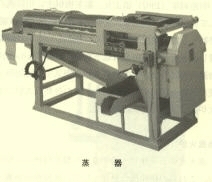 Steaming
machine Steaming
machine
Steaming tea leaves is first process of tea production,
therefore, steaming determined tea quality.
This machine steamed in a
short time in order not to make destroyed tea leaves because tea leaves needs to
undestroyed and keeps green by losing oxidization ferment effect in after
rubbing process. (30minutes)
|
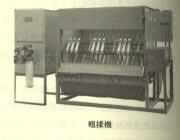 Cooling machine Cooling machine
Steamed tea leaves are cooled as well as
eliminate water of tea surface.
Rough rubing machine
Rough rubbing
machine rubs tea leaves by heating steamed tea leaves and force in order to make
tea leaves soft as well as reduced water of tea leaves 50%. (45 minutes)
|
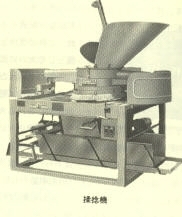 Second rubing machine Second rubing machine
Second rubbing machine gatheres
tea leaves and force gradually and turn in order that tea leaves water equally
spreaded and make tea leaves soft as well as destroyed tea leaves organization.
(20 minutes).
|
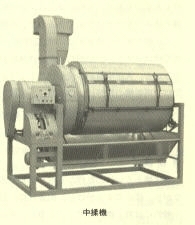 Middle rubing machine Middle rubing machine
Tea leaves are dried by heat wind
and shaped to twisted and keep water of tea leaves surface as well as evaporate
tea leaves water equally and be in order quality and shape. (40 minutes)
|
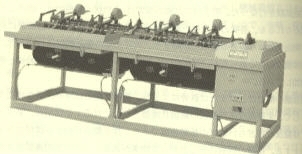 Redrying machine Redrying machine
Tea leaves are dried by heat wind and
shaped.
Final rubing machine
Tea leaves after middle rubbing
machine or redrying machine are heated indirectly and rubbed in order to shaped
to Sencha tea. Waters of tea leaves are reduced to 75%.
(40 minutes)
|
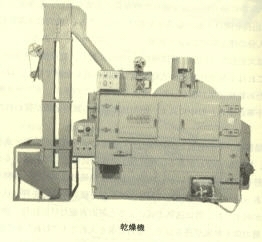 Drying machine Drying machine
Water of tea leaves after final rubbing
is 11%-14%, therefore, Water of tea leaves needs to be reduced 4%-5% in order to
preservation. In this process, Tea aroma and taste are created by heating.
|
Judgemant of Japanese green tea
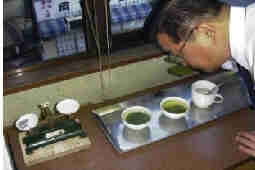
All people engaged in Japanese green tea business judged Japanese green tea by
4 criteria, appearance, aroma, color, taste.
There are two ways of judgment, judgment by sense and scientific judgment by
machine. Usually, we judge Japanese green tea by sense. In judging appearance,
150g of Japanese green teas are put on Judgment tray.
|
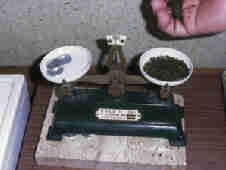
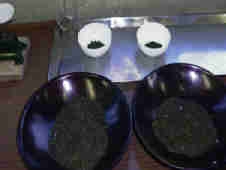
In judging aroma, color, taste, two 3g of Japanese green teas are put each tea
cup of balances.
Aroma judged by scooping tea and be close to nose. Taste is judged by scooping
tea liquid and tasted on tongue and after be out of mouth not drank. |
|
 Appearance Appearance
Shape and gloss are judged in appearance. Presence or equality of scale, tight
are judged. In judging gloss, nutrition of material tea leaves, production,
plucking time are judged.
Aroma
Preferable aroma is refreshed aroma that combined of flowery aroma, fruity
aroma, medical aroma, resinous aroma, and heated aroma.
Preferable Senate tea aromas are refreshed new leaves aroma, light heated
aroma, light flowery aroma.
Color
Color is judged by that tea leaves are eliminated and judged quickly before
temperature will be down. Tea leaves material, handling tea leaves, processing,
changing quality are judged.
Taste
Taste is important quality of Japanese green tea. Taste, refreshes, density,
sweetness, astringent and bitterness are judged. |

 In the process of Tamatoki.tea lumps made from rubbing are
untied.
In the process of Tamatoki.tea lumps made from rubbing are
untied.  First processing
First processing In the process of Dengurimomi, tea leaves are rubbed to shaped
needle like shape. (10 minutes to 20 minutes.)
In the process of Dengurimomi, tea leaves are rubbed to shaped
needle like shape. (10 minutes to 20 minutes.)
 In the process of Kokuri, tea leaves are shaped further and are
polished to gloss. (10 minutes to 20 minutes).
In the process of Kokuri, tea leaves are shaped further and are
polished to gloss. (10 minutes to 20 minutes).
 Steaming
machine
Steaming
machine Cooling machine
Cooling machine Second rubing machine
Second rubing machine Middle rubing machine
Middle rubing machine Redrying machine
Redrying machine Drying machine
Drying machine



